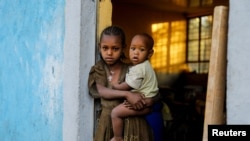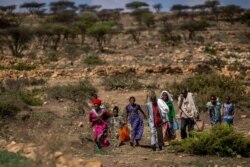Six months into the conflict in Ethiopia’s northern Tigray region, the specter of widespread hunger and starvation looms, as continued military operations and violence stall aid delivery and threaten the approaching planting season, according to the United Nations and several other observers.
The U.N. Office for the Coordination of Humanitarian Affairs (OCHA), which last week described the scale of food insecurity as “large and dire," said Wednesday that 5.2 million of the region’s roughly 6 million people needed food assistance.
“Armed hostilities” and “blockades by military forces have in recent days severely impeded access in rural areas where humanitarian needs are most severe,” OCHA said in a news briefing.
While noting “some positive news on Tigray’s humanitarian access," OCHA said the situation "remains fluid and unpredictable.”
Malnutrition increasing
Mari Carmen Viñoles, emergencies program manager for Medecins Sans Frontières (MSF), told VOA that the medical charity’s teams were seeing “an increased level of malnutrition.”
MSF reported last week that, beyond setting up support in larger towns such as Axum and Shire, it has used medical mobile teams to expand outreach to about 50 rural areas. Residents there have little access to drinking water and food distribution, MSF said.
Viñoles said MSF teams had found malnutrition among children, pregnant women and breastfeeding mothers. “We are very much concerned that if the food distributions are not effective … we are going to see even more increase of malnutrition cases,” she said, adding that without proper health care and food allocations, “they will die because of complications.”
Thousands already have been killed since November in fighting between allied forces of Ethiopia’s central government and the armed wing of the Tigray People’s Liberation Front (TPLF), which dominated Ethiopia’s politics and economy for almost two decades until Abiy Ahmed was appointed prime minister in 2018. Tensions between the prime minister and TPLF flared into clashes last year, triggering a government offensive in November.
The United Nations, the U.S. government, the European Union and international aid groups have been pressuring Abiy’s administration to do more to stem the violence and assist civilians. His administration has blamed atrocities — including rape and extrajudicial killings — on the TPLF.
Rebuilding Tigray?
In a series of Twitter posts Tuesday, Ethiopia’s Office of the Prime Minister said the government was taking measures to improve humanitarian conditions, communications, and access to aid groups and news media in the embattled Tigray region.
“#Ethiopia is committed to rebuilding #Tigray and ensuring that citizens are sufficiently provided for while #rebuilding efforts are being exerted,” one tweet read.
In an email to VOA on Friday, the U.N. said Ethiopia’s government was delivering food aid and was one of three food distributors in Tigray. The others are the World Food Program and the Joint Emergency Operation Program, international aid partners whose food distribution is funded by the U.S. Agency for International Development.
Dina Mufti, spokesperson for Ethiopia’s Ministry of Foreign Affairs, told VOA’s Amharic Service that entry visas for foreign aid workers would be granted for up to six months instead of the usual one-month period. The service reported Thursday that internet service had been restored to charitable organizations and government offices in the regional capital, Mekelle, though it remained down in much of the rest of the region.
The prime minister’s office also said the government would cooperate with a joint investigation by the independent Ethiopian Human Rights Commission (EHRC) and the U.N. Office of the High Commissioner for Human Rights into grave rights violations allegedly committed by combatants on all sides.
That includes troops from neighboring Eritrea who have been allied with Ethiopia’s federal forces and who, the EHRC found in a preliminary investigation, purportedly massacred more than 100 civilians in Axum in November.
Abiy said on March 26 that Eritrea would withdraw its troops. But roughly a month later, a CNN reporting team found Eritrean troops disguised as Ethiopian soldiers blocking humanitarian aid into the town of Axum, it said in an investigative report this week. The CNN team, which traveled to Axum on April 21 with the Ethiopian central government’s permission, visited a sparsely equipped teaching hospital. In one examination room, an emaciated 7-year-old girl was lying on a gurney. Health workers told CNN they had run out of vital therapeutic nourishment because of the blockade.
Accusation of intentional starvation
Hunger is being weaponized in the conflict, the World Peace Foundation at Tufts University in Massachusetts charged in a report released in April. It contended that Ethiopian federal forces, allied militia from the country’s Amhara region and Eritrean forces have been dismantling the economy and food systems in a deliberate effort to starve Tigray’s people.
Alex de Waal, the foundation’s executive director, told VOA in a recent interview that “enough information has leaked out about the deliberate destruction of foodstuffs, vandalism and destruction of clinics, the destruction of employment opportunities.
“And the level of rape, of sexual violence, is also extremely high and that is a starvation crime,” he said. “Many women and girls, because of fear of rape, are unable to do those essential activities — looking for food, going to market or even going to look for assistance — that would keep themselves and their families alive.”
Viñoles, of MSF, said a halt in fighting was essential not only to allow aid delivery but also to ensure that farmers could safely return to their fields in the approaching planting season.
The U.N.’s Food and Agriculture Organization is giving emergency supplies of wheat, teff and chickpea seed to 20,000 farming households affected by the conflict, OCHA said. The U.N. said last week that it was disbursing $65 million for humanitarian needs in Ethiopia, including $40 million for aid to Tigray.
The United States remains the largest donor of humanitarian aid to Ethiopia, providing more than $305 million since the conflict began.
Contributors to this report included Jason Patinkin of VOA English to Africa Service; Tsion Girma and Solomon Abate Gebremariam of VOA’s Horn of Africa Service; Cindy Saine, reporting from the State Department; and Carol Guensburg, Africa Division bridge editor.













